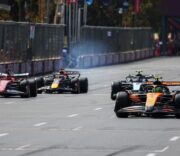
From low-ride-height strength to sudden weakness
All season long, McLaren had earned a reputation for running its car low to the ground without falling foul of the skid plank rules, especially at the rear of the MCL39. The car’s ability to operate close to the track surface was widely seen as a key ingredient of its performance surge, giving strong downforce and stable balance on a variety of circuits.
That is why the Las Vegas Grand Prix turned so many heads. The FIA arrived in Nevada with a tightened interpretation of the rules around skid blocks and plank preservation, closing off loopholes that some teams were using to support the plank and reduce wear. The aim was simple: stop cars from effectively bypassing the minimum ride-height intent of the regulations.
On paper, those changes should have hurt teams that had been flirting closest with the limits. Yet it was McLaren, a squad praised for staying on the right side of the rules while running low, that ended up as the most dramatic casualty of the new clampdown.
The irony calls to mind the old Tommy Cooper gag: “It hurts when I do this.” The doctor says, “Then don’t do it.” In Las Vegas, McLaren essentially “kept doing it” with its low ride-height philosophy on a brutal street circuit, and the pain came later in scrutineering.
What actually happened in Las Vegas: plank wear and double disqualification
On track, the weekend initially looked like another McLaren showcase. Lando Norris took pole position at the Las Vegas Strip Circuit, with Oscar Piastri also lining up near the sharp end. In the race Norris finished second and Piastri fourth, apparently limiting the damage to Max Verstappen, who had grabbed the victory for Red Bull.
The consequence is automatic and severe: disqualification from the results. Norris and Piastri were both thrown out of the race classification, marking the first time in Formula 1 history that both McLaren cars had been disqualified from a Grand Prix.
McLaren did not contest the basic facts. The team accepted that the plank wear was outside the allowed limits but pointed to a series of contributing factors: unexpectedly aggressive porpoising, harsh bumps and kerbs on the new street layout, and limited practice running thanks to poor weather, which made it harder to validate ride heights over a full race stint. Team principal Andrea Stella publicly apologised to both drivers and the fans, stressing that there was no intent to break the rules and that the breach was a technical miscalculation rather than a deliberate gamble.
Why the paddock was surprised – and what it means for the title fight
The shock in the paddock came from the identity of the offender. McLaren had been seen as one of the “cleanest” exponents of low ride heights, a team that found a sweet spot between peak performance and legal plank wear. The FIA’s technical directive targeted more extreme interpretations of the rules, and many expected rivals to be the ones paying the price.
Instead, conditions in Las Vegas turned McLaren’s usual strengths into a trap. A cold night race, a fast but bumpy street circuit with big braking zones, and the push to keep the car in its optimal aero window may all have combined to overload the plank over 50 laps. What looked fine over short practice and qualifying runs became marginal – and then illegal – over a full Grand Prix distance.
The sporting consequences are huge. Before the disqualifications, Norris had finished second on track and held a 30-point lead in the standings. After being excluded, his advantage shrank to 24 points over Verstappen, with both the Dutchman and Piastri now tied behind him on 366 points and only two rounds left in Qatar and Abu Dhabi. McLaren has already wrapped up the constructors’ title, but its dream of closing out the drivers’ championship comfortably has become far more complicated.
For the FIA, the Las Vegas episode underlines that its plank-wear rules still have teeth. For McLaren, it is a painful reminder that even a well-understood concept can bite when the environment changes and the margin to legality is razor-thin.
And for everyone else, the lesson sounds a lot like that old Tommy Cooper punchline: if Vegas punishes you when you run the car that low… maybe, next time, just don’t do it.































